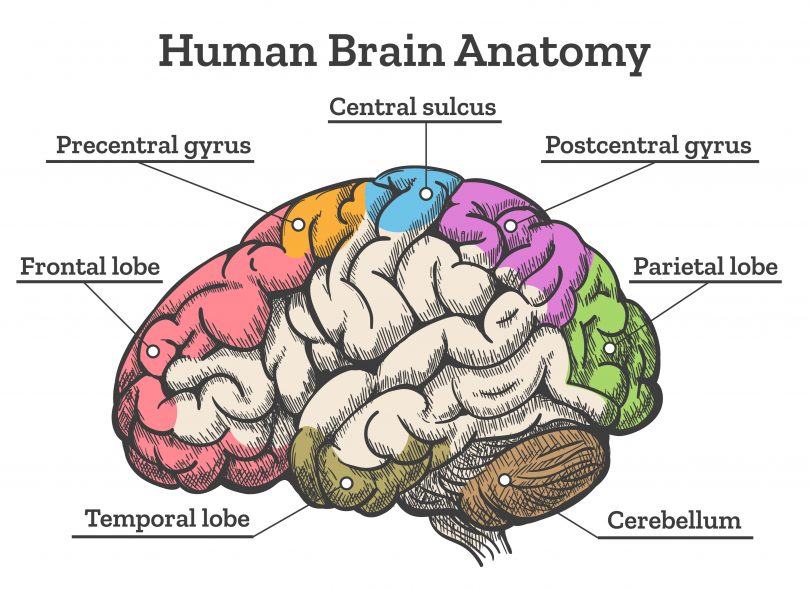A new study published just last month in JAMA Psychiatry claims that teenage cannabis use can negatively alter brain structure… but how accurate is this claim and exactly what factors and variables did the researchers consider in coming to this conclusion?
Childhood and adolescence are critical times for physical and emotional development. Until we reach adulthood, our brains change considerably by growing in size, modifying number of cells and structure, and opening more connective pathways. During our late teenage years, the outer layers of the brain begin to lose some thickness and density in a process known as “cortical thinning”. Cortical thinning is a completely normal part of cerebral development, but, according to the study, the rate of thinning is accelerated in cannabis-using teens. Lead researcher Matthew Albaugh, a clinical psychologist and assistant professor at the University of Vermont Medical Center, says that “it is unclear what will happen” if the thinning process occurs to quickly.
Cannabis is a powerful, yet controversial, tool. Despite the drama, we know that cannabis has so much therapeutic potential and access to safe, legitimate products is of utmost importance. If you’re a cannabis connoisseur and you’d like to learn more about this fascinating plant, as well as gain access to exclusive deals on flowers and other products, make sure to subscribe to The CBD Flowers Weekly Newsletter. If legal THC is more your thing, head on over to The Delta 8 Weekly Newsletter and check out the selection of deals on Delta 8, Delta 10, THC-O, THCV, and other fun tetra products.
Teens and Cannabis
Cannabis is one of the most frequently used illicit substances by all age groups, especially youth. What’s interesting, however, is that although rate of use among older adults is rising in legal states, that has not been the case with teens and young adults. As Kayla Tormohlen, Ph.D. candidate, from Johns Hopkins Bloomberg School of Public Health stated, “Since the implementation of retail marijuana sales, we haven’t seen an increase in use among youth, but we are seeing a difference in how young people are consuming.”
Take a look at these stats:
- 6.9% of 12th graders use cannabis daily.
- 43.7% have tried cannabis in their lifetime.
- 35.2% consumed cannabis in the last year.
- 2.4% used synthetic marijuana, also known as K2 or Spice, in the last year.
- 62.8% of 12th graders who used cannabis in the last year consumed it via vaping.
- 12th graders are 82.1% more likely to use marijuana in their lifetime than they are to smoke a cigarette.
A growing number of adolescent cannabis users are more inclined to vape, dab, or eat edibles rather than smoking flower. A couple years ago, a survey-based study published in JAMA Pediatrics found that in Colorado, teen cannabis smoking saw a significant decrease. According to the study, from the students questioned in 2017, around 78% of teens who admitted to using cannabis said they did so by smoking. That number was down from 87% in 2015.
About the Study
In this study, Albaugh’s team evaluated data from a separate study of teenage brain development, conducted over a multi-year period in Europe. A total of 799 participants had their brains scanned once at 14 years of age, and one more time when they turned 19 years old.
Lifetime cannabis use ranged from 1 to more than 40 uses, with roughly half of participants falling somewhere in between 10 and 30 estimated uses. Using this self-reported data (meaning researchers simply asked the teens about their cannabis use over the last five years), and two brain scans over the course of a half-decade, researchers concluded that there were “significant brain differences” in the teens who used cannabis and those who didn’t.
“Results suggest that cannabis use during middle to late adolescence may be associated with altered cerebral cortical development, particularly in regions rich in cannabinoid 1 receptors. Cannabis-related cortical thinning in the right dorsomedial prefrontal cortex accounted for unique variance in attentional impulsiveness at 5-year follow-up while controlling for sex, site, baseline age, baseline brain volume, baseline pubertal development, verbal IQ, and performance IQ. Thus, accelerated thinning in the right dorsomedial prefrontal cortex was associated with the transition to cannabis use as well as greater attentional impulsiveness at 5-year follow-up.”
In plain English, it means that adolescent cannabis use can cause accelerated cortical thinning, which may lead to questionable impulse control in young adults. Researchers emphasized there was a direct correlation between rate of use and rate of cortical thinning, meaning those who used more pot experienced more discernable structural differences. They also stated that confounding variables like sex, age, IQ, and so forth, were accounted for, but no environmental factors were considered. Additionally, the study mentions that alcohol was controlled for as well, but tobacco use and other carcinogens were not.
Personal Observations and Unanswered Questions
There are numerous aspects to this study that will naturally require some further observation, starting with the fact that it’s relying entirely on the self-reported data of teenagers. Assuming that teens can remember exactly how many times they used cannabis over an extended time period of five years, is a very unlikely gamble. Also, whether the questions were answered with complete honesty is another issue. Numerous studies have found that participants often lie in surveys of counternormative behaviors, such as drug use and abortion. It’s not a stretch to assume that some of the teens were concerned the results could negatively impact their futures, come back to bite them in some way, and they weren’t entirely forthcoming. But again, these are just personal theories.
Of further concern to me, is how few confounding factors were actually accounted for. The study claims that controlling for sex, socioeconomic status, and IQ did not “meaningfully” alter the results (although some negligible differences were observed), but many other things can lead to rapid cortical thinning as well. Alcohol consumption was controlled for, but personally, but it’s quite likely that 800 teens who experimented with cannabis use also drank occasionally. If moderate cannabis use can impact the brain, what are the effects of limited alcohol exposure on young minds?
Best THC-O Carts: Top THC-O Vape Cartridges of 2021
Tobacco/nicotine use was not controlled for during the study, and at the 5-year follow up, regular tobacco use was correlated with regular cannabis use. According to numerous medical texts on the subject, the adolescent brain is especially sensitive to the damaging effects of nicotine. Studies in human subjects have found that smoking cigarettes during teen years leads to a greatly increased risk of developing cognitive impairment and various psychiatric disorders later in life.
Researchers did mention they went back and found that, “rerunning the longitudinal analysis and including lifetime tobacco use as a covariate resulted in largely consistent findings.” Based on my understanding, they just revisited the number and updated the algorithm to include possible tobacco use, but still, in the original study, it was not controlled for. Also, it is worth noting that use of other illicit drugs and prescription medications, diets, and exposure to environmental toxins were not largely considered during this research project either.
And finally, they mentioned impulsivity as the final “negative” result following varying rates of teen cannabis use. It’s important to remember that the second scan was conducted when participants were only 19 years of age. The human brain is not fully developed until we reach our mid-twenties, so it is difficult to say whether the impulsive behaviors would carry over into adult years or what the actual long term (10+ years) effects of cannabis use are.
This study also doesn’t fully clarify whether cannabis caused the impulsive behaviors. What parameters are used to measure impulsivity? You need to be relatively uninhibited to be willing to experiment with illegal drugs in the first place, so how likely is it that these teens were impulsive before using cannabis, and not the other way around?
Conflicting Research
Medical research, although very important, is subjective to a degree. This is why we need repeatable results from numerous different studies looking at a diverse range of socioeconomic and geographical data. This study claims that adolescent cannabis use has negative impacts on the brain, but numerous other studies say the exact opposite. For example, a significantly larger study published just two years ago in the journal Drug and Alcohol Dependence, spanning over an even longer period of time, claimed there were no differences at all in the brain structure of cannabis-using teens compared to their counterparts who abstained.
The study followed a group of 1000 subjects starting in the 1980s and continuing for about 15 years, with testing and brain scans performed at various points throughout the course of the research period, and found that “adolescent cannabis use is not associated with lasting structural brain differences.”
As the study authors pointed out, “Even subjects with the highest level of cannabis exposure in adolescence showed subcortical brain volumes and cortical brain volumes and thickness in adulthood that were similar to boys with almost no exposure to cannabis throughout adolescence.” Put simply, no matter how much cannabis was used during teenage years, there were no noticeable effects on brain formation.
Unrelated to cannabis entirely, if we’re following medical literature, it’s up for debate whether cortical thinning is even a bad thing or not. While this study maintains that cortical thickness has some type of relation to impulsive behaviors, others have found that cortical thickness was not related to cognitive performance at all. Better yet, this study claims that early adolescent cortical thinning actually translated to better neuropsychological outcomes.
Conflicts of Interest
Medicinal cannabis use has a long history in traditional eastern healthcare – and by long I mean centuries. It was not uncommon for cannabis, with its very mild side effects, to be used at a treatment option for numerous childhood ailments. Obviously no clinical trials have been conducted on these ancient subjects, but medical practitioners of the times did keep their own detailed records and it was never noted that any brain damage or behavioral changes occurred in people who used cannabis throughout their lives.
Of course, the westernized among us would argue that without sound scientific research, there is absolutely no way to determine whether cannabis was/is safe or not. Fair enough, but there is one considerable difference between old-school medical literature and the modern studies of today – funding. These days, there are so many conflicts of interest surrounding medical research that you really have to dig deep into who’s paying for a study and what their underlying motives are.
This particular experiment was funded by numerous entities, including many big-name pharmaceutical companies such as Eli Lilly, Pfizer, Bristol Myers Squibb, and Vifor. Big Pharma is a longtime enemy of cannabis reform and the pharmaceutical industry has spent millions over the years lobbying against marijuana legalization.
Final Thoughts – Cannabis, Teens, and Brain Development
Point blank, brain studies are difficult because it is impossible to account for every confounding variable in someone’s life. The food they eat, the area the live in, the air they breathe, toxins consumed, rate of alcohol and tobacco use, genetics, and so much more can affect the way a person’s brain develops. Cannabis is popular among teens, so of course people want to know if it is safe. However, many more studies over longer periods of time are needed before we can have more clarity on this issue, and this most recent study does not suffice.
Thank you for stopping by CBD TESTERS, your hub for all the lasted in the cannabis industry. For more articles like this one, and exclusive deals on flowers and other products, don’t forget to subscribe to The CBD Flowers Weekly Newsletter.







